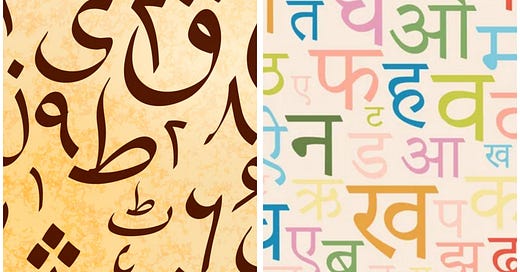Welcome to the Brown History Newsletter. If you’re enjoying this labour of love, please do consider becoming a paid subscriber. Your contribution would help pay the writers and illustrators and support this weekly publication. If you like to submit a writing piece, please send me a pitch by email at brownhistory1947@gmail.com. Check out our Shop and our Podcast. You can also follow us on Instagram and Twitter.
The Intertwined History of Hindi and Urdu by Vishavjeet Dhaliwal
In today’s increasingly sectarian climate, communities in South Asia seem more detached from one another than ever. Religion continues to demarcate people who have otherwise inextricable pasts. In the short 75 years since the partition of British India, both Indians and Pakistanis have solidified fiercely intense national identities that frequently overlook our shared heritage.
This is mirrored in the case of Hindi and Urdu, often seen as separate languages with separate cultural identities. Hindi is spoken by Hindus, while Urdu is the language of Muslims. Urdu is Pakistan’s official language, whereas Hindi is spoken across North India. Urdu is written in an Islamic Perso-Arabic script, reflecting its plethora of Persian and Arabic loanwords, while Hindi is written in Indic Devanagari characters.
But as with most cases in South Asia, the reality is far more complicated. So how did these two languages emerge, and why did they become synonymous with two seemingly opposite identities?





